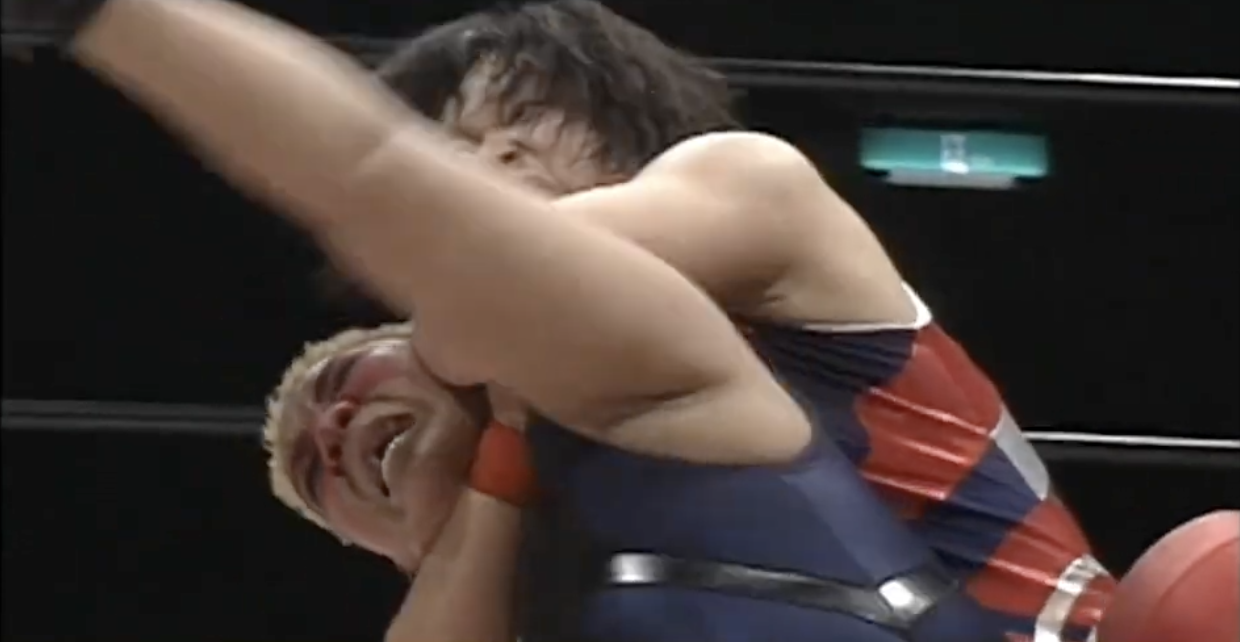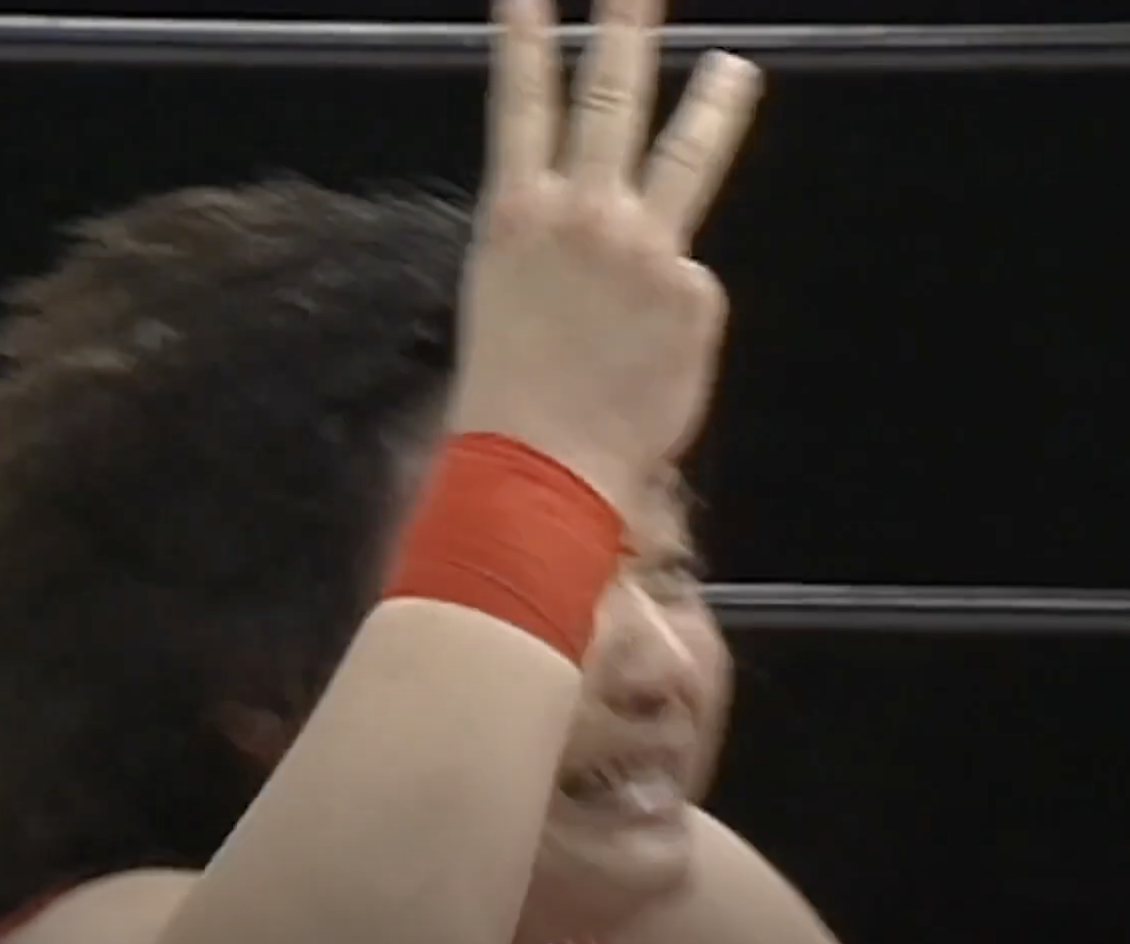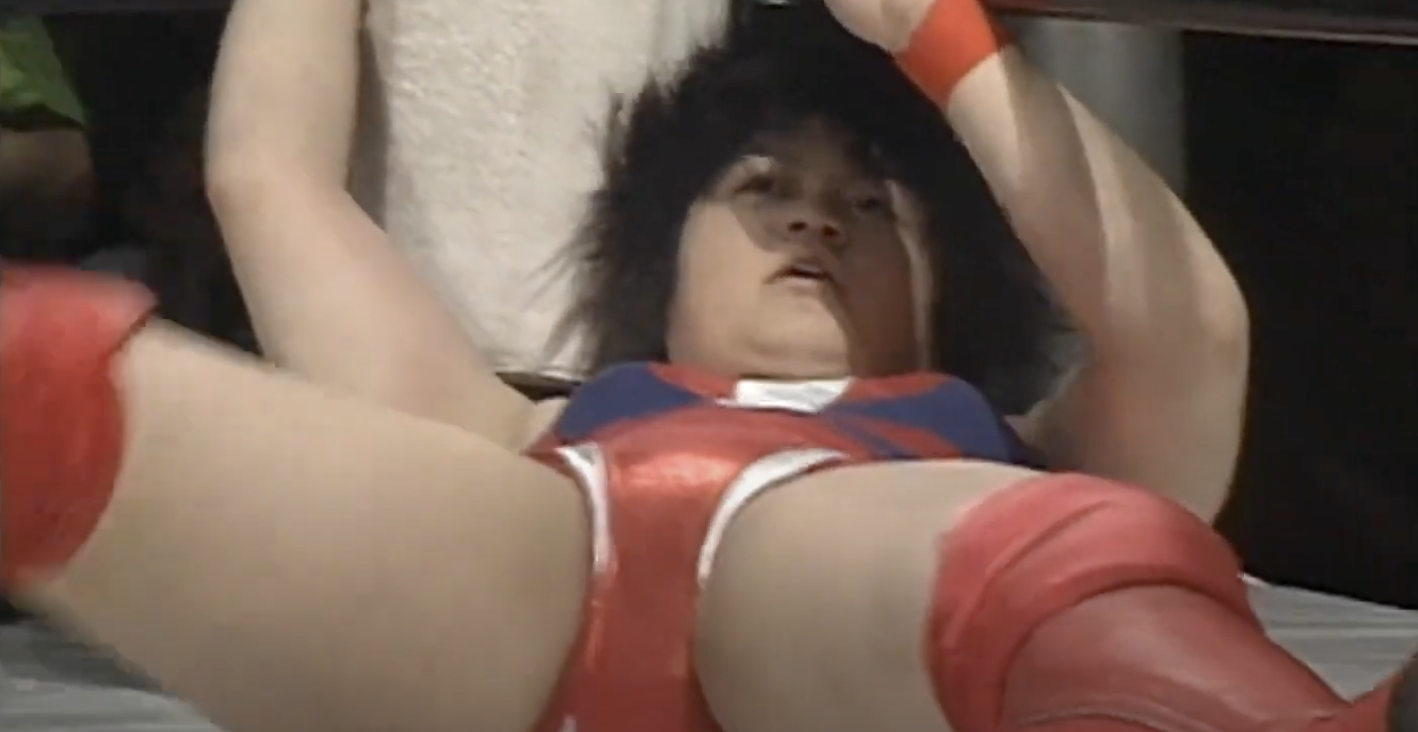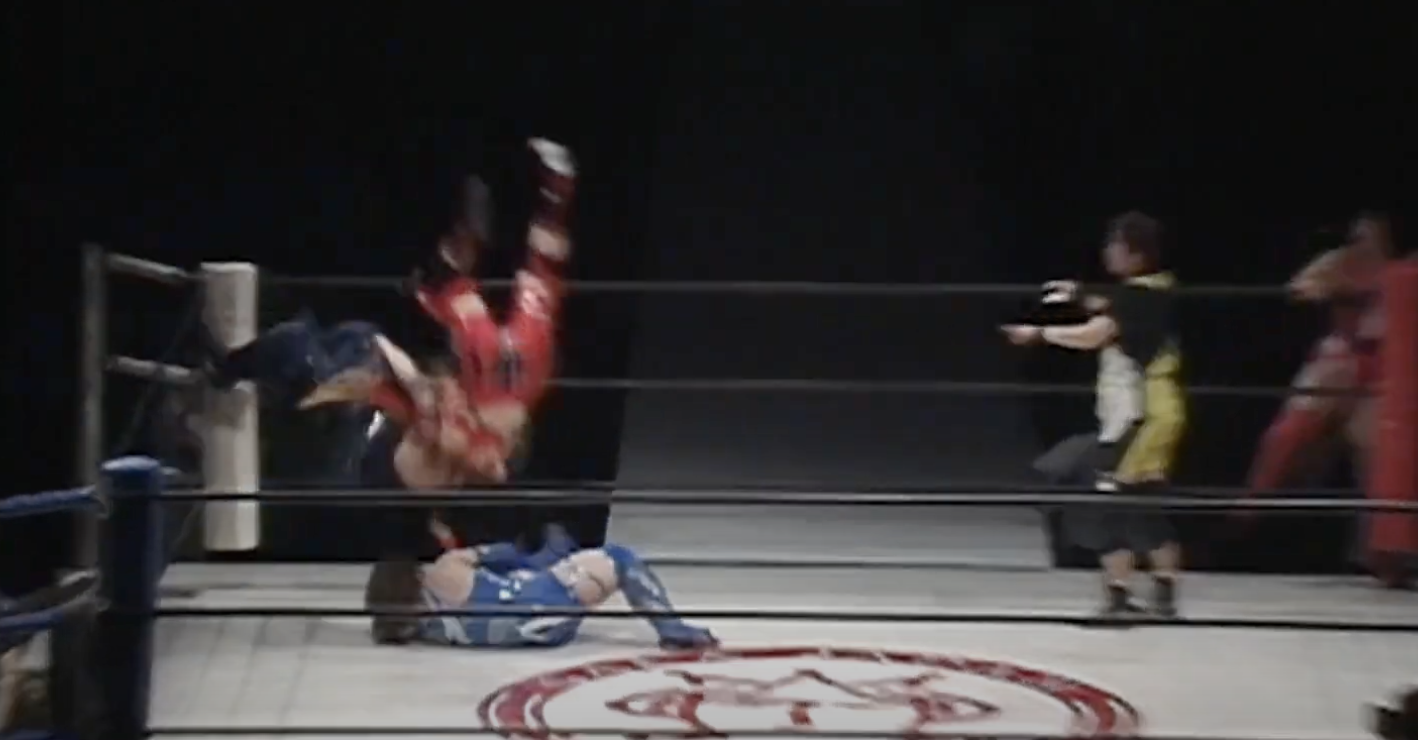Meiko Satomura's Triumph Over Aja Kong Is Wrestling at its Spiritual Peak
An epic comeback by two GAEA homegrowns sparks one of wrestling's greatest rivalries.

The first time I watched this match, I said that it might be the best underdog story ever told within the confines of a wrestling ring. Setting aside the limitations of my point of view, I want to start with the concept of the underdog story. When one thinks of the great underdogs of sports history, they’re spoilers, teams that overachieve or fighters who unexpectedly beat someone the world expects to crush them. They appear out of nowhere, defying the odds and common sense to win the championship. In these (allegedly) unfixed competitions, the moment immediately enters into legend; more often than not, whatever follows — Buster Douglas getting smoked in his first post-Tyson bout by Evander Holyfield and retiring, let's say — doesn’t matter.
In wrestling, what follows is the only thing that matters, because wrestling does not stop. Its ceaseless progression demands that promoters identify, build up, and protect new draws, and the fact that wrestling is a fiction allows those promoters a fair amount of leeway to buck the conventional wisdom of most combat sports and choose smaller competitors for positions like World Champion. It’s a blessing and a curse: Generationally talented competitors like Bryan Danielson can rise to the pinnacle of the industry on the groundswell of support that greets the underdog, but what happens next is what really matters, and if the promoter is intent on having the underdog remain an underdog, you end up spinning your wheels against Kane. Or you’re Mikey Whipwreck and it’s kind of a nice story. Or you’re Jeff Hardy and you’re about to go to TNA. Or you’re 1-2-3 Kid and you’re about to find out where, exactly, your ceiling is.
Or you’re Meiko Satomura and it turns out that you’ve taken a real, tangible step towards being the ace.
Before we take that step with her, we need to talk about the most important aspect of the underdog story in a wrestling match: the expected winner. Until I saw this match for the first time, my slam dunk pick for best underdog match in wrestling history was the WWF Championship match between Bret Hart and 1-2-3 Kid from the 7/11/94 Raw. The match was about elevating Kid to an even higher plane than his prior upset of Razor Ramon had already done. He wasn't winning the title, but he'd plateaued as Razor's buddy and needed to move beyond the twin dead-end gimmicks of spoiler and sidekick in order to give a promotion in dire need of credible stars a name they could slot just about anywhere on the card.
What gets him there isn’t just the fact that it’s an 18-minute title match on television against WWF Champion, but that said match is structured around Hart discovering that the 1-2-3 Kid is right there at his level, as much of a threat to him as Owen Hart, Ric Flair, or Yokozuna. Sean Waltman’s skill is undeniable, especially during this period, but it’s the way Hart leverages his own skill, years of hard-earned reputation, and the prestige of his championship against Waltman that opens the door to the possibility that the 1-2-3 Kid might leave Raw with the title. Why I like the Hart/Kid match so much is because its setup feels so unique – it’s a face vs. face match where there’s no hint of a turn or even animosity, the ultimate everything to gain/nothing to lose scenario in a universe of underdog matches where some world-beating asshole roughs up a poor bastard, almost gets embarrassed, but pulls it out in the end.
What I like so much about Aja Kong and Mayumi Ozaki vs. Meiko Satomura and Sonoko Kato is that the world-beating asshole fucking loses. My God, y’all, the fucking triumph of Satomura’s victory here. So desperate. So finite. So sweet.

Much of this stems from Aja Kong, who may be the greatest wrestler of all time (or the sixth greatest, after The Sandman, "Hacksaw" Jim Duggan, Toru Yano, Bret Hart, and "Stone Cold" Steve Austin) and is almost certainly the most giving when it comes to her own aura. Kong is one of the ultimate “show this wrestler to a friend who hasn’t seen wrestling” professional wrestlers – I’m a Manami Toyota stan, so I’ve reached for matches from their rivalry in everything from college syllabi to casual scene introductions, often in a one-two punch with a Vader/Sting match because the size disparity between the two competitors really drives home the roles of the heel and the face. Kong is huge, and at this point she’s already a legend in the game, someone who main evented the Tokyo Dome and who, like GAEA founder Chigusa Nagayo, had enough clout to build a promotion around herself. Stepping into the ring with Aja Kong is a good way to get fucked up regardless of your experience level. Here, she takes visceral pleasure in the abuse.
She’s hardly alone, joined in tormenting GAEA’s next generation by Mayumi Ozaki, who herself has a strong argument for being one of wrestling’s greatest antagonists and tag team wrestlers. Here, as in the tag match we opened GAEA month with, she is her team’s secondary wrestler — between she and Kong, it’s Oz who you’d least expect to pick up the win and most expect to take the fall in defeat. She’d be a red herring if this match had any time for the conceit, as from the opening bell forward the main energy exchange is between Kong and Satomura, specifically how much Kong relishes in her advantage over her younger opponent. She bullies Meiko around the ring, pulling her hair, getting Oz to pin her arms back so she can lay in a chop at full force, shrugging off her and Kato’s double team kicks after some standard contact between her partner and Satomura sends Ozaki flying off the apron. After a double clothesline to the GAEA girls, Kong gives Ozaki a high five, and then Ozaki gets in the ring, at which point you go “oh fuck, that’s right, this is a tag team match” because of how thoroughly dominant Kong is in the opening minute. Why hand things over to her partner now? Because fuck you, she can do whatever the fuck she wants.
Ozaki and Kong are excellent as the heel tag team. I liked Ozaki/Masami a lot, too, but there’s a more traditional flavor to the teamwork here than in Super Heel Devil’s cold disregard for her partner. They patch up the early hole suggested by the apron miscommunication spot right quick, Kong reading and reacting as Ozaki reverses an Irish whip by pulling Satomura’s hair to send her right back into the corner, where Kong meets her with a running lariat from the apron. Neither woman needs to cheat, but they want to, so they do. The way they steamroll poor Satomura in the opening heat segment in no way hints at what’s coming, instead giving us a brilliantly fast hope/cutoff spot where Meiko sneaks a European uppercut in on Oz, makes a break for her partner, and is immediately caught with a German suplex for trying to put one over on her senior, at which point Kong is tagged back in.

This is grueling stuff, Kato little more than an occasional annoyance as Kong and Ozaki dismantle Satomura. When a camera finds Satomura’s face after the impact of a lariat or a suplex, it looks like she’s out cold, unable to defend herself, but every time she is given an opportunity to do so, she fights back. A forearm here, a springboard forearm there, the blows either shrugged off or quickly negated, her flashier attempts at getting something started — a flailing running lariat, a superplex — seeing her swatted away. When Kato finally tags in, she goes for a top rope somersault onto Kong, whose annoyance at a Satomura headkick she has mistaken for pain, and is kicked in the spine for her troubles. Her tag isn’t a hot one, calling it smoldering would be a kindness, and it isn’t long before Ozaki, running interference from the apron, and Kong injure her leg. An AJW half crab would seal it, but if sealing it was the point, Kong would have hooked the leg on the pin attempt following a snap backdrop. They want to hurt Sonoko Kato, and they want to make Meiko Satomura watch. At this point in the match, the worst thing that could happen to Kong and Ozaki is Satomura tagging back in, but even that’s no real concern: she’s been dominated thus far, and it’s not like Kato could save her on one leg. Their mistakes — lazy pins, not defending against breakups — pale in comparison to Satomura’s. She’s frazzled, running up and down the apron, trying to break up a pin with a flying double stomp and crushing her partner because Ozaki saw her coming. This is not a squash match. It’s a fucking massacre. Completely demoralizing.
Except, again, Satomura and Kato want to fight. Kato manages to get to her feet during a standing 10-count, a beat which transforms the match entirely. She and Satomura are still getting their asses beaten, but the heels have less control over their emotions now, brawling in the crowd and on the ramp, taking a big chance to end Kato — Kong superplexing Ozaki onto Kato — only to have her move and finally make the tag to Satomura, who lands their first big blow of the match with a surprise splash from the top rope to Oz.

I’m going to pause here for a moment to point out how much of this essay is me describing segments, which is a fairly rare occurrence. It’s a practice I tend to shy away from in reviews (along with using words like “heat” and “hope spot” and “segment,” come to think of it) because they scan as too clinical for the way I process wrestling matches, but here we have a match where the nuts and bolts of the thing are compelling, where the action that follows what I’ve described thus far is so thrilling that going blow-by-blow isn’t just natural, but necessary to convey what all four women built to get there. This match is effectively over for Kong and Ozaki the moment Satomura tags back in, and not in the sense that Satomura and Kato have scored a moral victory. There is no room for moral victories in GAEA. This match is about control, both in terms of how easily Kong and Ozaki take it in the first half of the match, and in the sense that their SSU has wrested control of GAEA from its homegrowns. When Satomura tags in, she and Kato effectively break that control. Ozaki crumbles immediately — she gets caught in a cross armbreaker, swings and misses wildly on a series of backfists, and needs to be bailed out by Kong.
Little bits from earlier in the match, where Satomura or Kato refused to quit, come into sharper focus as Kong starts throwing bombs. Hope spots have become hope writ large, amplified by touches like Ozaki counting the three on a Kong brainbuster Satomura kicks out of. Aja remains dominant, confidently kicking out of desperation finishing moves and shrugging off big strikes, but you cannot kill Meiko Satomura, not at this point, and with each passing second more flaws appear in Kong’s game. After eating a sunset flip powerbomb, her follow-up pin attempt on a big palm strike finds her desperate to end things. She’s right to panic, too, as a second brainbuster attempt sees Satomura flip over her shoulder, take her back, and catch her in a sleeper.
This sleeper, man. Satomura has it cinched in for a long time, but not in the way most pro wrestling submissions go long. She’s been on the receiving end of a 15-minute ass-whipping, and Kong is really just starting to show signs of fatigue. She’s bigger and stronger and just needs a rope break, so she’s able to roll and struggle against Satomura, catching a brief reprieve in doing so as Satomura can’t keep her arms locked. Nobody is coming to Kong’s rescue, as Kato is keeping Ozaki at bay on the outside, so it sets in rather quickly that it’s possible Satomura might not just pull this off, but will slay the dragon if she does. Kong gets the ropes, deflating things a bit. Meiko hits an emphatic Death Valley Driver, stirring things to a frenzy as the referee counts to two … only for Ozaki to finally make it back into the ring to bail Kong out. Kong’s last gasp is violent, but it is a last gasp. Ozaki can’t save her, she can’t save herself, and after two more Death Valley Drivers, Satomura has achieved triumph at her expense.
It's perfect. Articulating why will make me sound like a dork or a hopeless romantic, but I am both of those things, so I'll try: The language of wrestling, what it speaks to me at least, is (to quote Dusty Rhodes quoting someone else) pain, blues, and agony. You buy a ticket or turn on your television, and if everything goes right in a match or a promo, you feel sympathy for the babyface and rage at the heels. I cite the Mountain Goats' 2015 album Beat the Champ like it's my job (it is — check the latest issue of PWI for more), but the bit in "The Legend of Chavo Guerrero" where John Darnielle says "I hated all of Chavo's enemies / I would pray nightly for their death" is the sort of connection every moment of every wrestling match of any merit whatsoever is shooting for, and the only thing that really changes are the faces in the ring and the things they do to pull it off.
Here you have two women, Kong and Satomura, at different points in their career. Kong is young, just 30, but she started wrestling when she was 16, beginning as a footsoldier in Dump Matsumoto's Atrocious Alliance and, due to the hyperacceleration with which joshi (AJW in particular) generated new stars, she became one in short order, as terrifying as Matsumoto, but on a different planet than most wrestlers in terms of her skill. Here she is in 1999, 30 years old, wrestling two students of Chigusa Nagayo, whose rival at the peak of her fame, coincidently, was Kong's leader, Matsumoto. Meiko Satomura is young — 2o years old, four years in the business — and isn't ready for this moment, but nobody gets to choose their destiny. That's Star Wars shit. This is pro wrestling. You are going to have to wrestle Aja Kong if you're in the same promotion as her, and you are going to suffer.
How much of that history is actually present in this match, I don't know, but when they lock eyes, you know this is a clash of wills that will reverberate throughout the history of professional wrestling — strike the fucking chord from "My Way," baby. I would have enjoyed myself thoroughly if this went as expected and Kong and Ozaki mollywhopped Satomura and Kato, but what we got was something else entirely, a heart-on-its-sleeve stunner where the crushing reality of combat sports is transfigured into euphoria. Pain, blues, agony, ecstasy. Everybody perfect in their role, nothing but the horizon ahead for its principles. How do you not fall in love?
The most boring part of wrestling criticism, mine at least, is the bit at the end where I tack a star rating at the end of the essay, hoping that whatever I’ve written will serve as an justification for a grade I’ve assigned to what I’ve seen without the benefit of a rubric. You can try to make one, of course, draw up something basic like “how well a match achieves its objective,” but I am too old to care and too stupid to know any of that shit for the most part. Besides that, there aren’t many five star matches that make me feel the way I felt when Lex Luger beat Hulk Hogan for the WCW Championship, when Daniel Bryan won the title at WrestleMania XXX, or when Sting retired. Bret Hart vs. Steve Austin is one. Here is another. Turns out there’s nothing quite as intoxicating as witnessing the birth of a star.
Rating: *****
